Anatomy and Physiology II - Section 3, Lesson 4
1/150
There's no tags or description
Looks like no tags are added yet.
Name | Mastery | Learn | Test | Matching | Spaced |
|---|
No study sessions yet.
151 Terms
What is another name for the oral cavity?
Answer:
The buccal cavity
What structures frame the mouth?
Answer:
The cheeks, tongue, and palate
Why are lips red?
Answer:
Lips are highly vascular with a thin layer of keratin, allowing blood to show through.
What is the function of the orbicularis oris muscle?
Answer:
It regulates what enters and exits the mouth
What is the labial frenulum?
Answer:
A midline fold of mucous membrane attaching the inner lip to the gums
What muscles help keep food inside the mouth when chewing?
Answer:
The buccinator muscles (cheeks) and the orbicularis oris (lips)
What is the oral vestibule?
Answer:
The space between the gums/teeth and the cheeks/lips
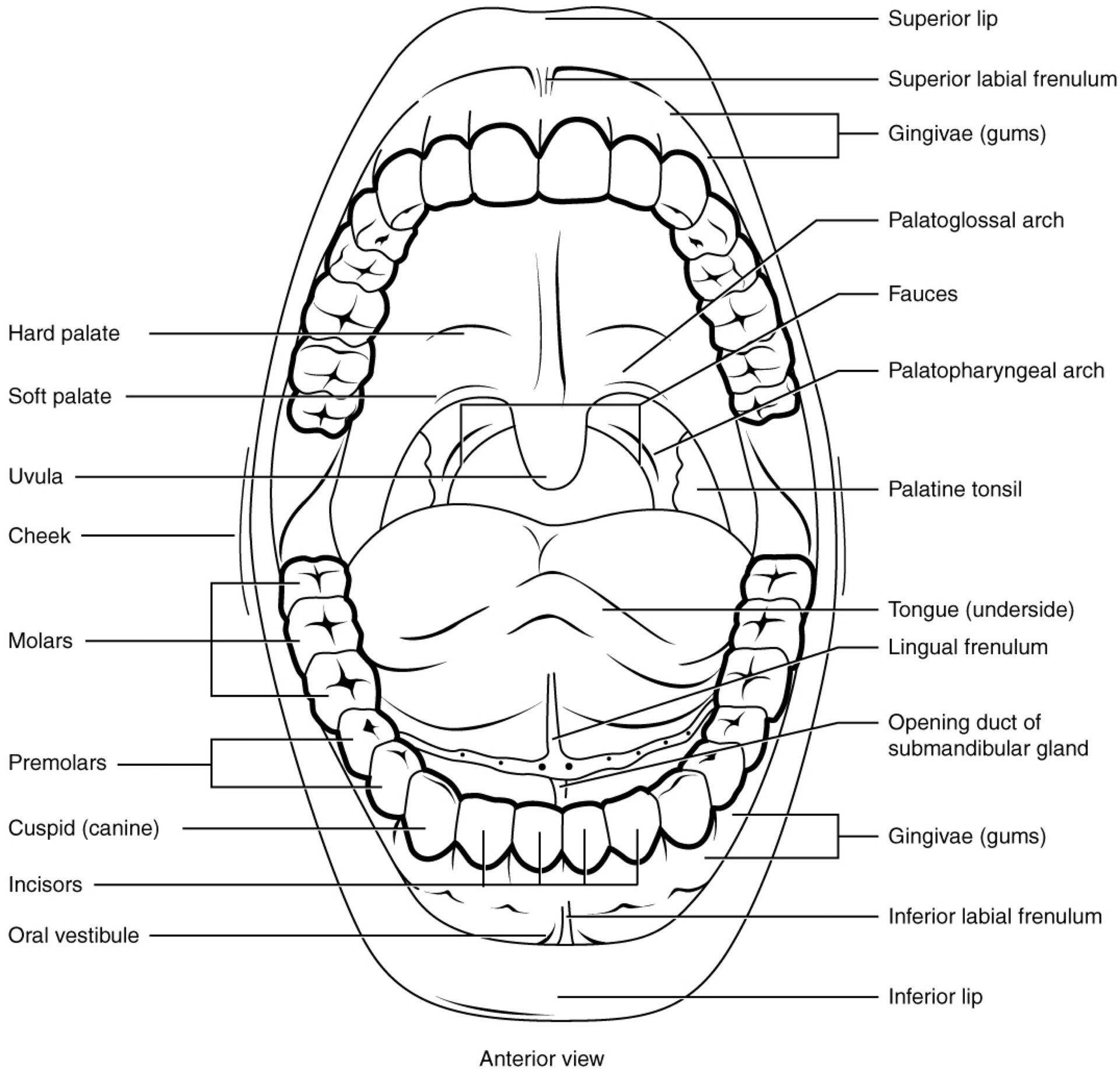
What are the fauces?
Answer:
The opening between the oral cavity and the oropharynx
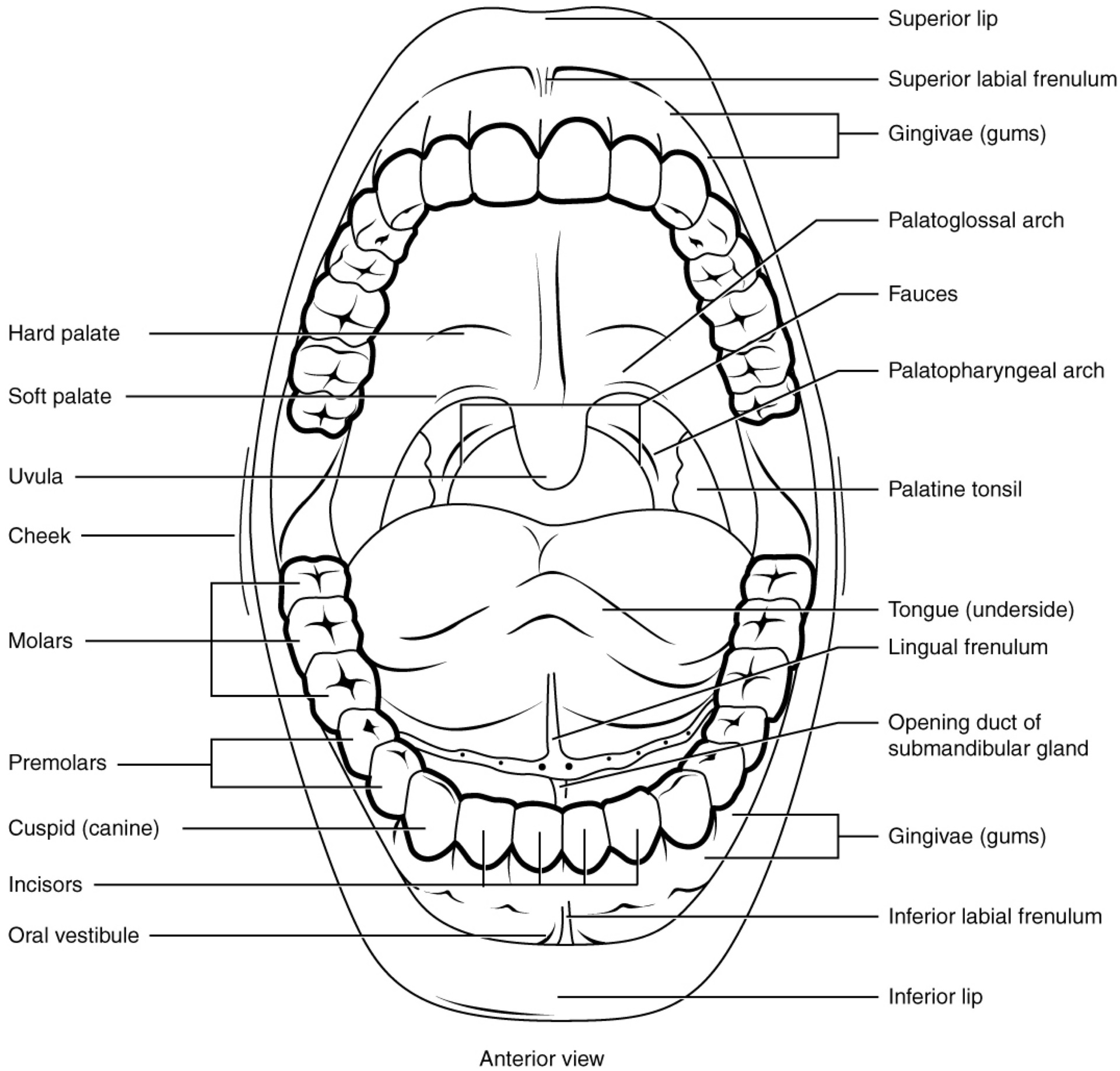
What is the main open area of the mouth called?
Answer:
The oral cavity proper
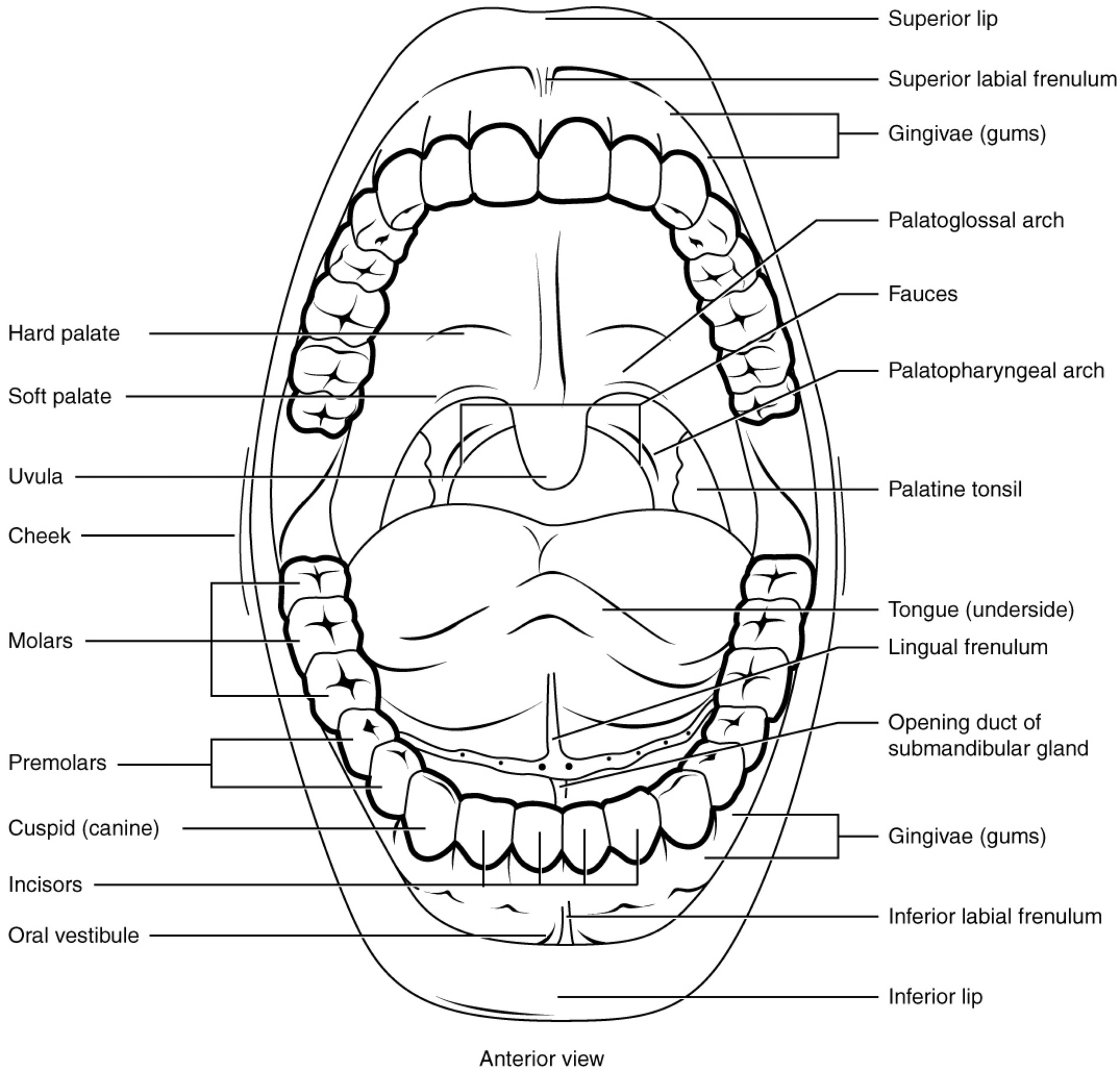
What is the function of the hard palate?
Answer:
It forms a rigid roof for the mouth, separating oral and nasal cavities, and helps the tongue push food
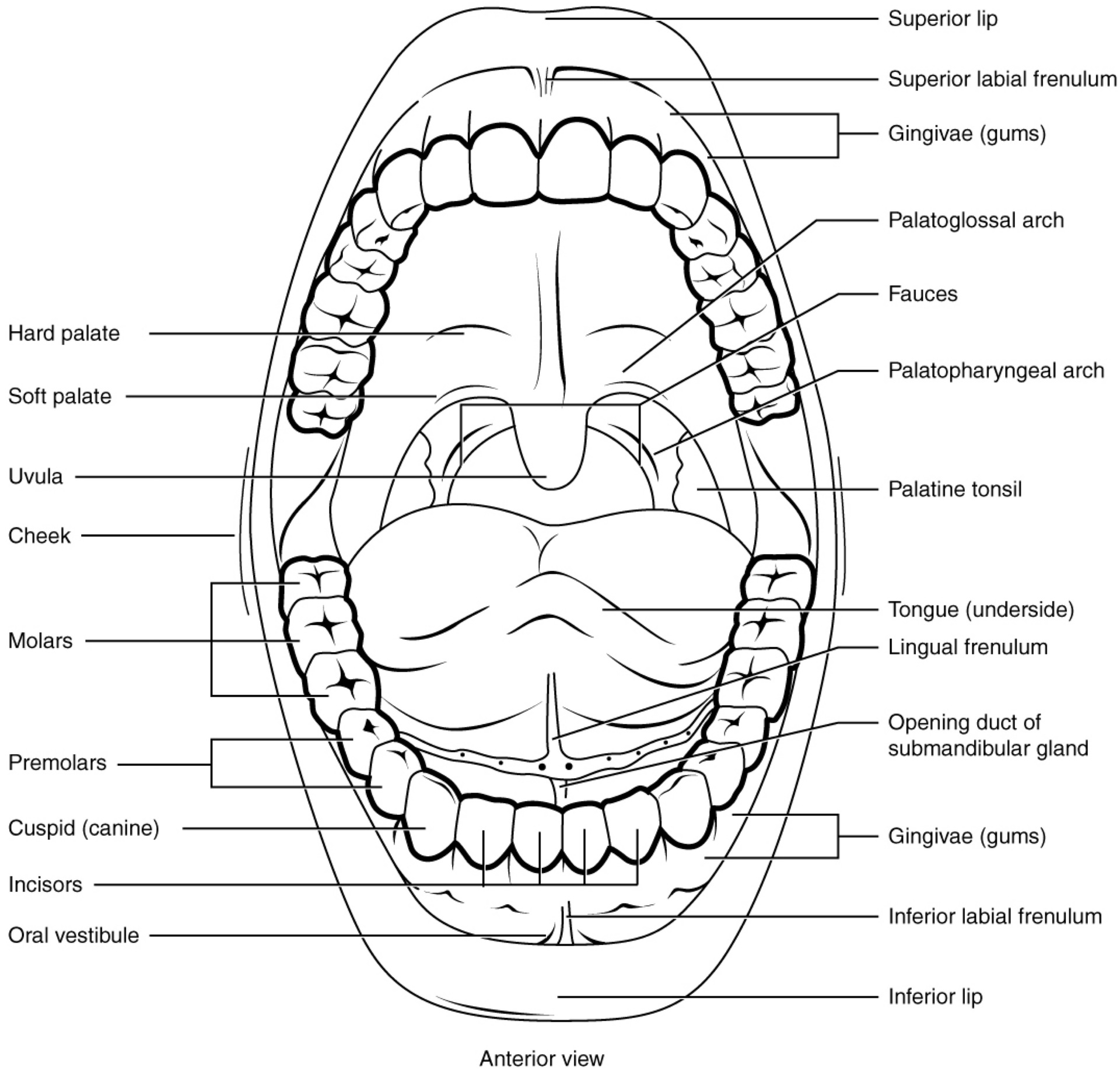
What bones form the hard palate?
Answer:
The maxillary and palatine bones
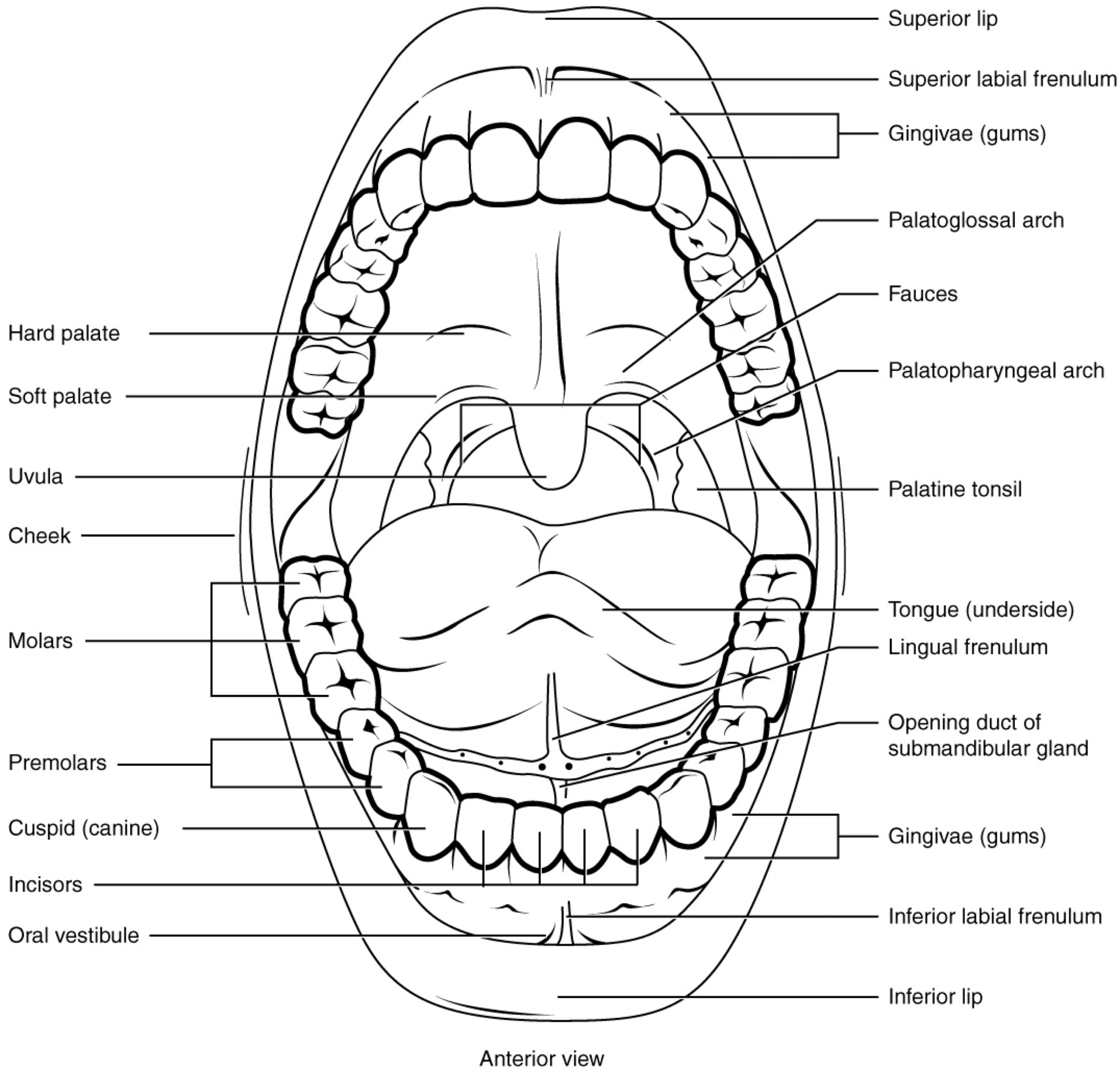
What is the soft palate made of?
Answer:
Skeletal muscle (flexible, helps in yawning, swallowing, singing)
What is the uvula and what is its function?
Answer:
A fleshy bead of tissue hanging from the soft palate; it moves upward during swallowing to prevent food and liquids from entering the nasal cavity
What are the two arches near the uvula and where are they located?
Answer:
Palatoglossal arch: next to the base of the tongue
Palatopharyngeal arch: behind the palatoglossal arch; forms the lateral margins of the fauces
Where are the palatine tonsils located?
Answer:
Between the palatoglossal and palatopharyngeal arches
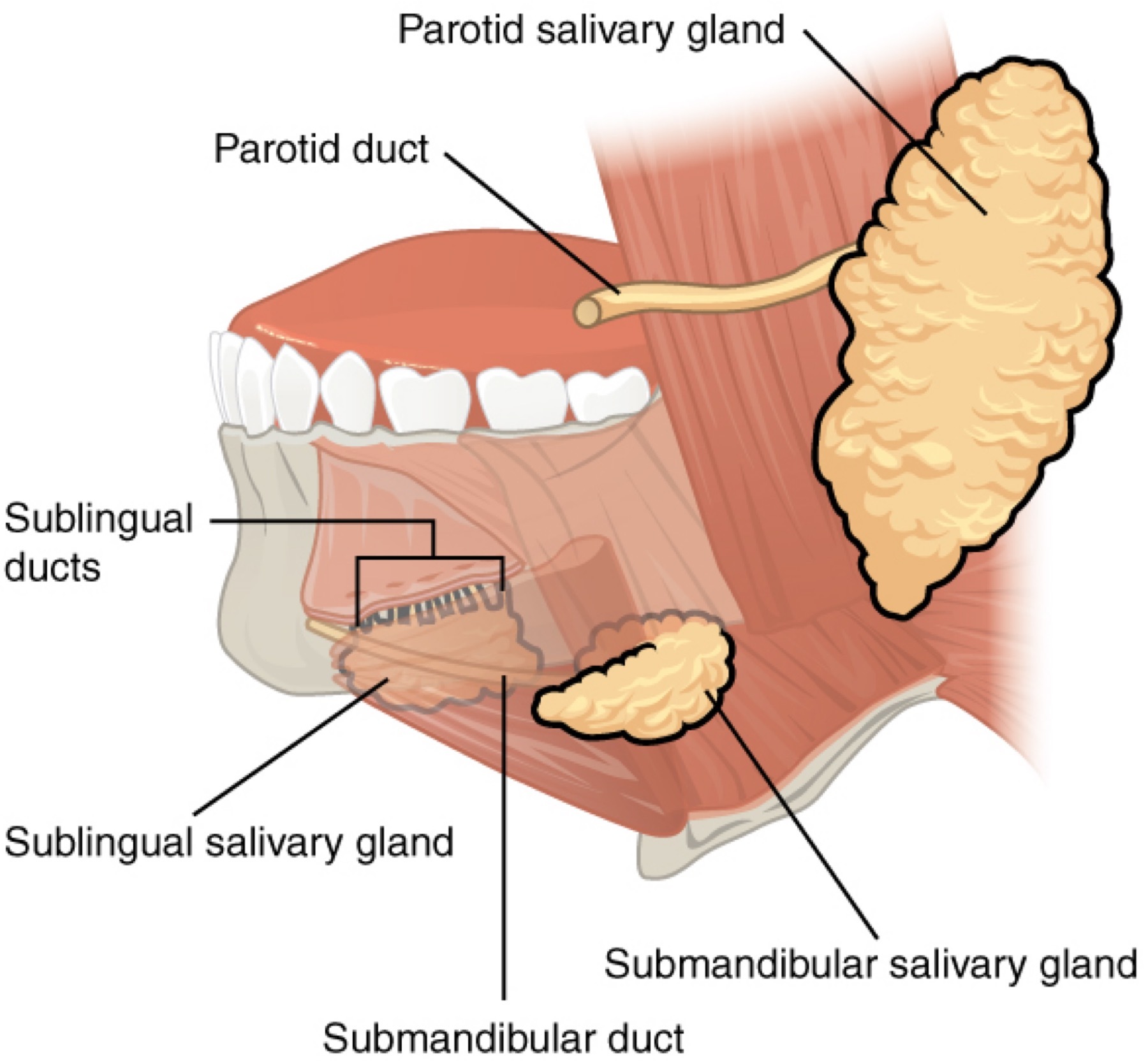
Where are the lingual tonsils found?
Answer:
At the base of the tongue
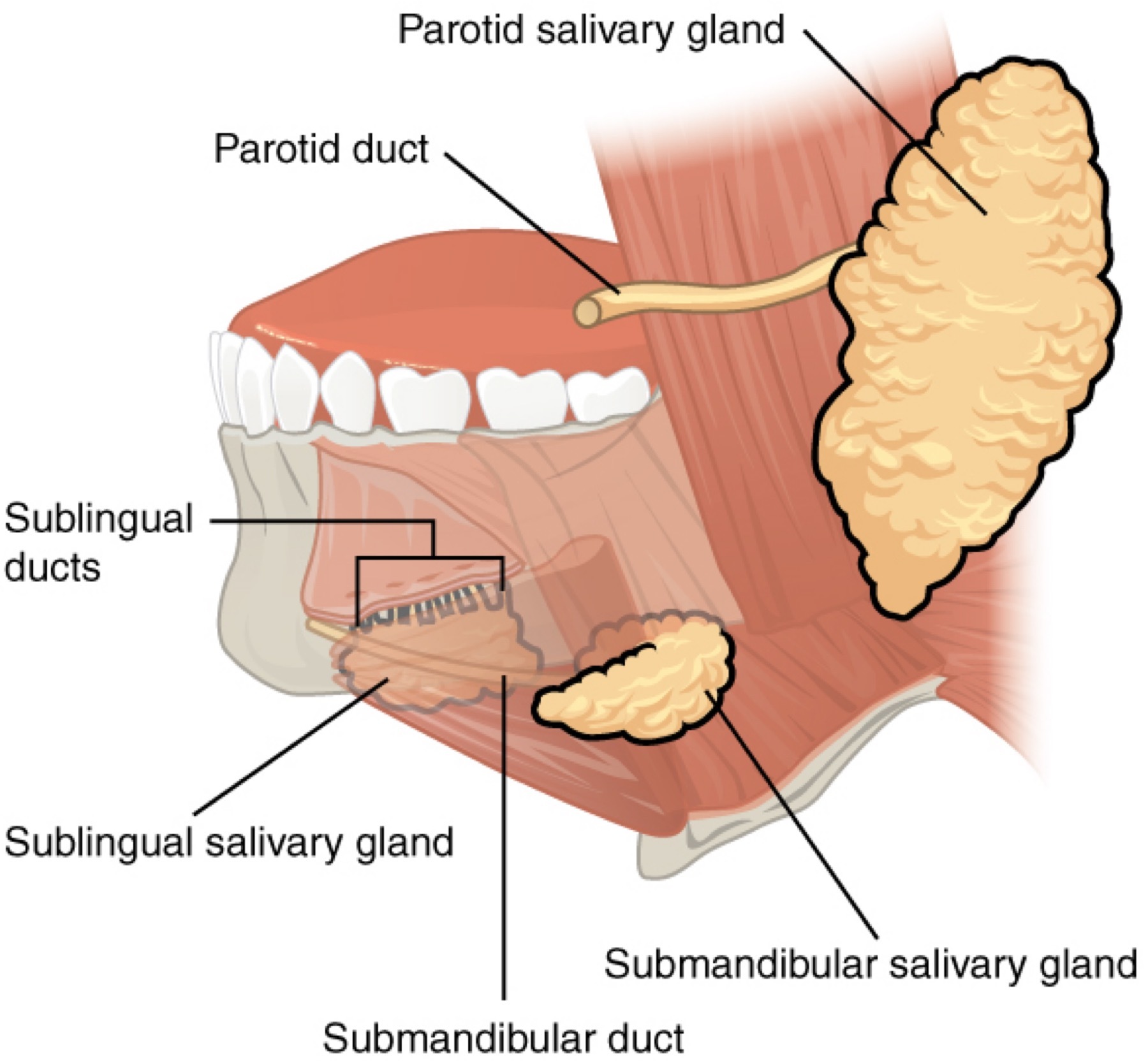
What are the functions of the minor salivary glands?
Answer:
They constantly secrete saliva to keep the mouth and teeth moist; increase secretion during eating
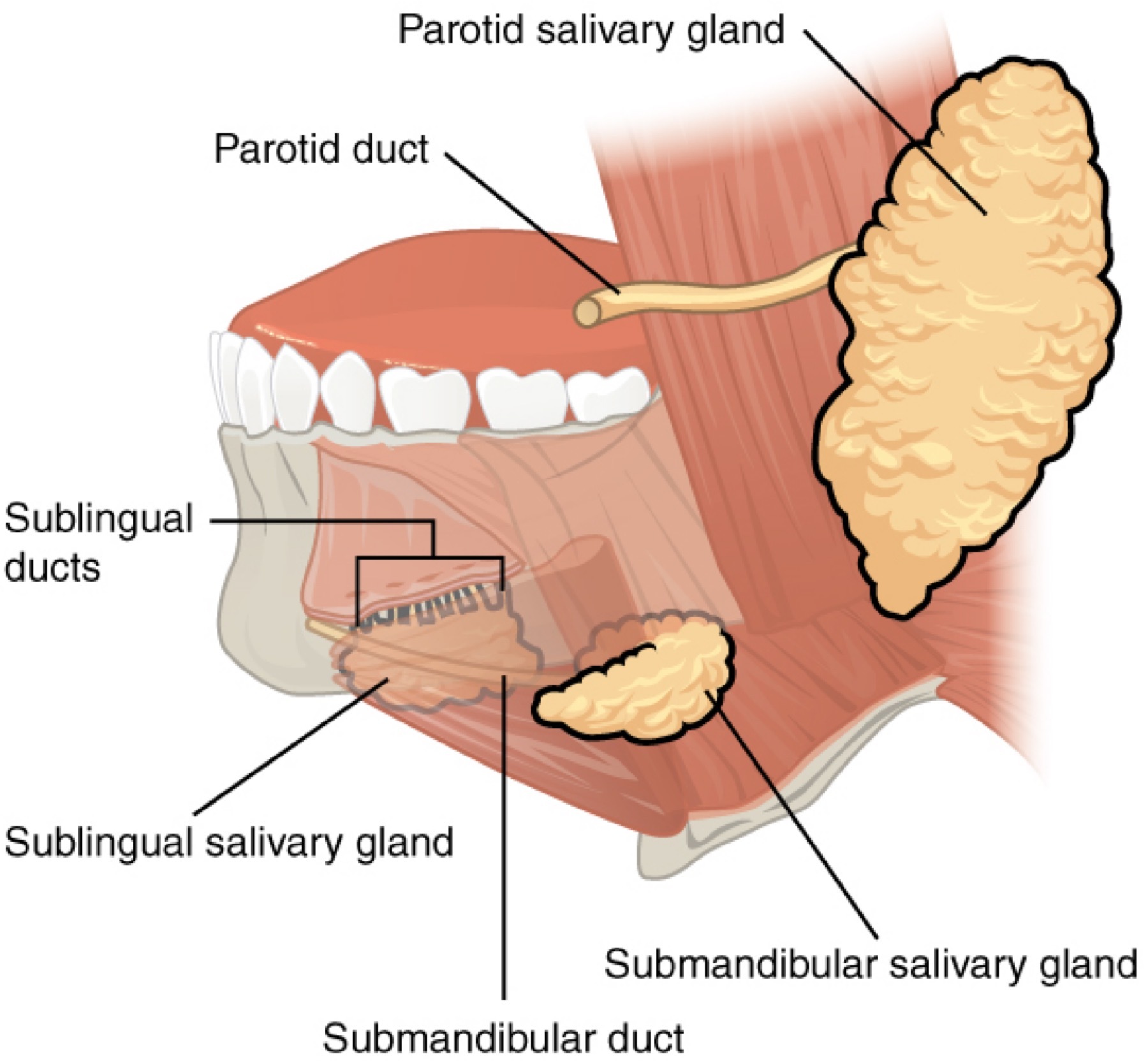
Name the three major salivary glands.
Answer:
Parotid glands
Submandibular glands
Sublingual glands
Which salivary gland is located near the ears and what duct does it use?
Answer:
Parotid gland; uses the parotid duct (opens near the 2nd upper molar)
Which salivary gland is found in the floor of the mouth?
Answer:
Submandibular gland; uses the submandibular duct
Which gland lies below the tongue and how does it secrete?
Answer:
Sublingual gland; uses lesser sublingual ducts
What enzyme in saliva begins the chemical breakdown of carbohydrates?
Answer:
Salivary amylase
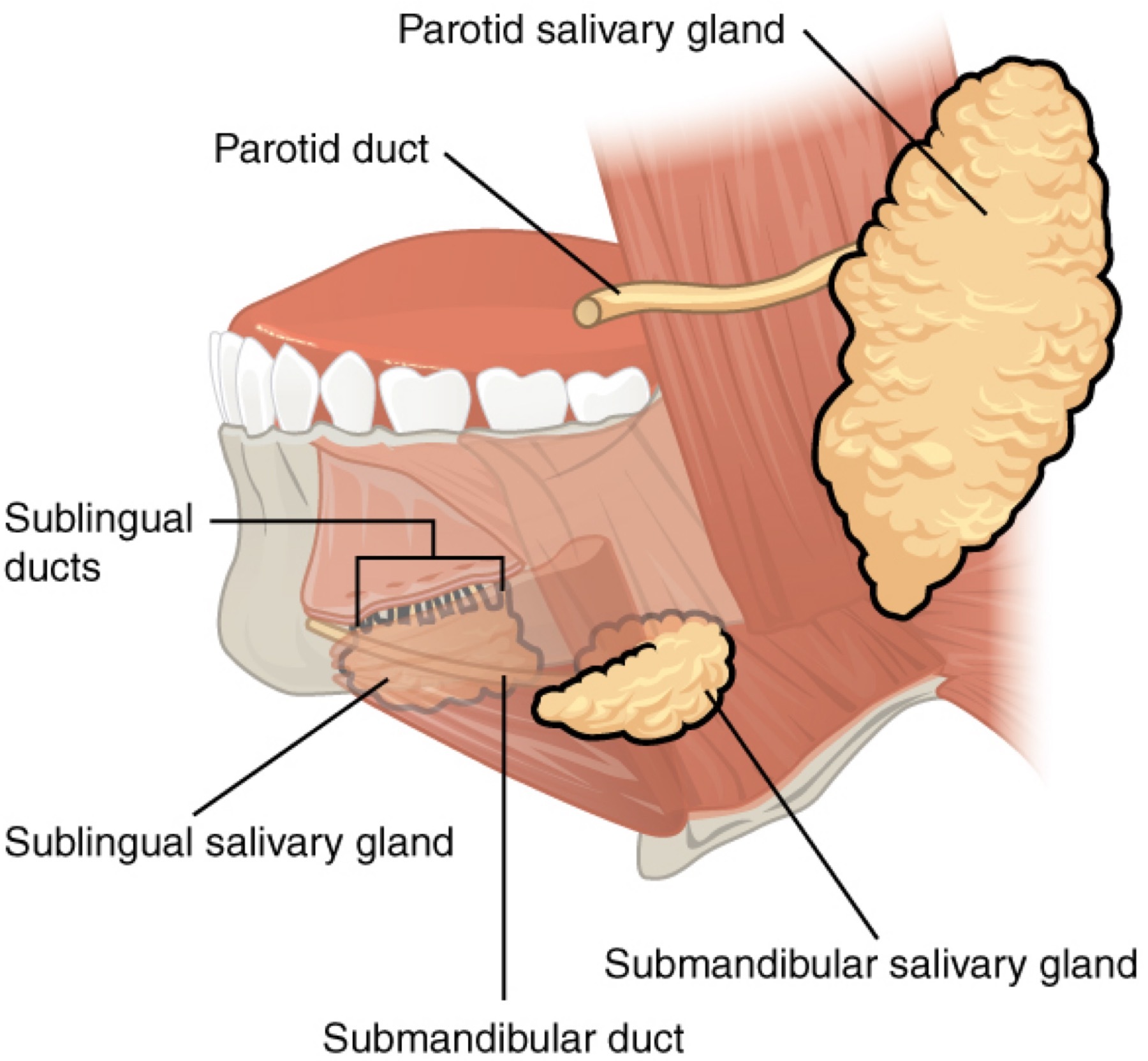
What is the pH range of saliva and what maintains it?
Answer:
6.35–6.85, maintained by bicarbonate and phosphate ions

What immune components are found in saliva?
Answer:
Immunoglobulin A (IgA) – prevents microbial penetration
Lysozyme – antimicrobial enzyme
What is unique about the secretion of each major salivary gland?
Answer:
Parotid: watery saliva with amylase
Submandibular: amylase + mucus
Sublingual: mostly mucus, thickest saliva with least amylase
What regulates the secretion of saliva?
Answer:
The autonomic nervous system (ANS)
What role does the parasympathetic nervous system play in salivation?
Answer:
It maintains a steady flow of saliva for speaking, swallowing, and general comfort
What triggers over-salivation (e.g., drooling)?
Answer:
Stimulation by smell, sight, or thought of food without consumption
How does sympathetic stimulation affect salivation?
Answer:
It reduces salivation, often causing dry mouth, especially during stress or anxiety
What happens to salivation when you're dehydrated?
Answer:
Salivation is reduced, leading to a dry mouth that signals thirst
What stimulates salivation during eating?
Answer:
Chemicals in food activate taste receptors → impulses to salivatory nuclei in brain stem → parasympathetic impulses via glossopharyngeal and facial nerves
What happens to saliva after you swallow food?
Answer:
Salivation increases to help cleanse the mouth and neutralize irritants
Most of this saliva is swallowed and reabsorbed
Which salivary gland lies above the masseter muscle and near the ears?
Parotid
Sublingual
Submandibular
Buccal
Parotid

What is the main component of saliva?
Water (99.4%)
Which structure is located in the posterior part of the oral cavity and is primarily composed of skeletal muscle?
Soft palate
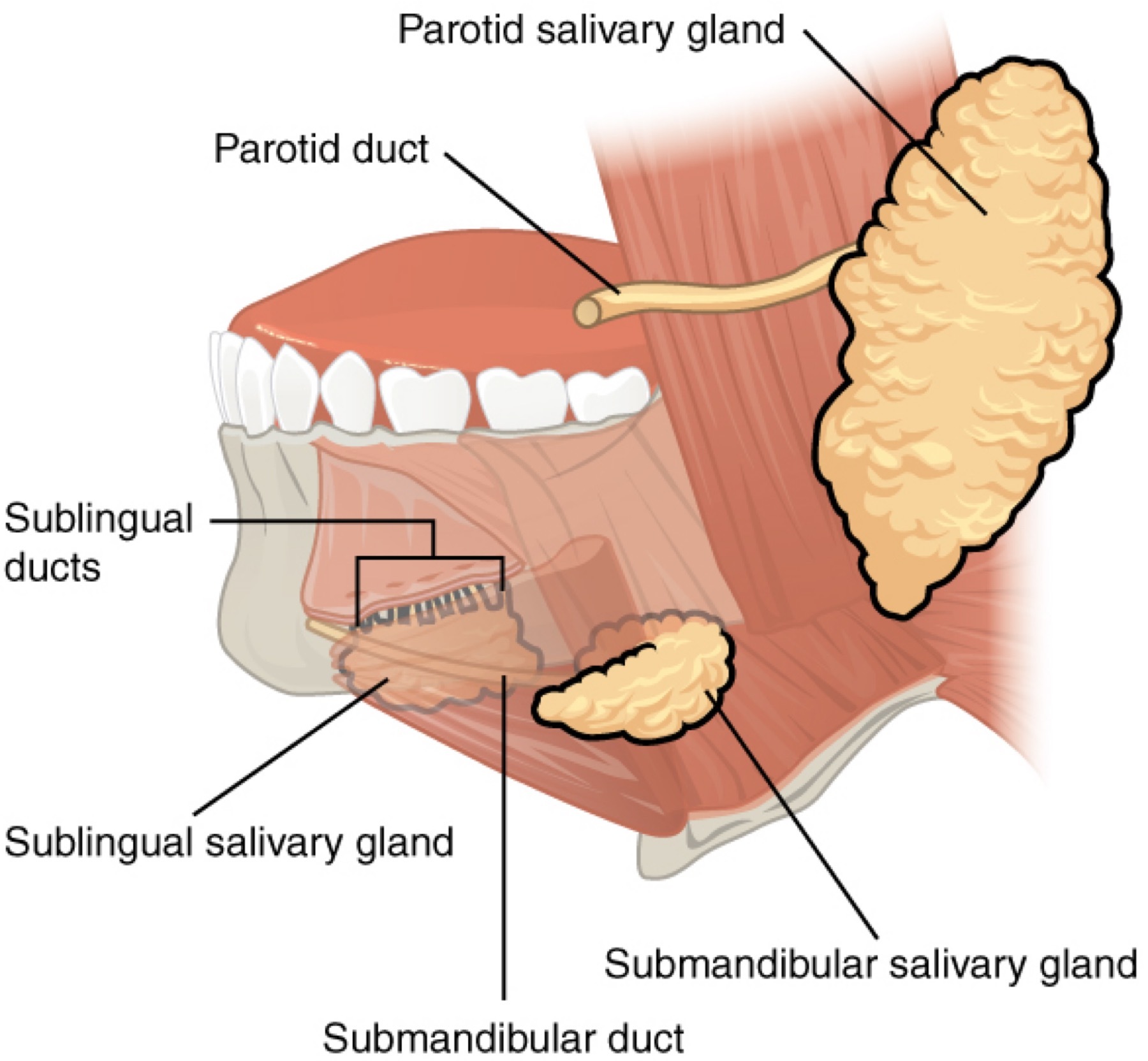
What is the oral cavity also called?
Answer:
Buccal cavity
What are the labia?
Answer:
The lips
What is the oral vestibule?
Answer:
Part of the mouth between cheeks/lips (outside) and teeth/gums (inside)
What are the fauces?
Answer:
The opening between the oral cavity and the oropharynx

What is the soft palate made of?
Answer:
Skeletal muscle; allows voluntary movements like swallowing and yawning
Flashcard 1: What are the primary functions of the tongue?
Answer:
Ingestion
Mechanical digestion
Chemical digestion (via lingual lipase)
Sensation (taste, texture, temperature)
Swallowing
Vocalization
What bones is the tongue attached to?
Answer:
Mandible
Styloid processes of temporal bones
Hyoid bone (which only indirectly articulates with other bones)
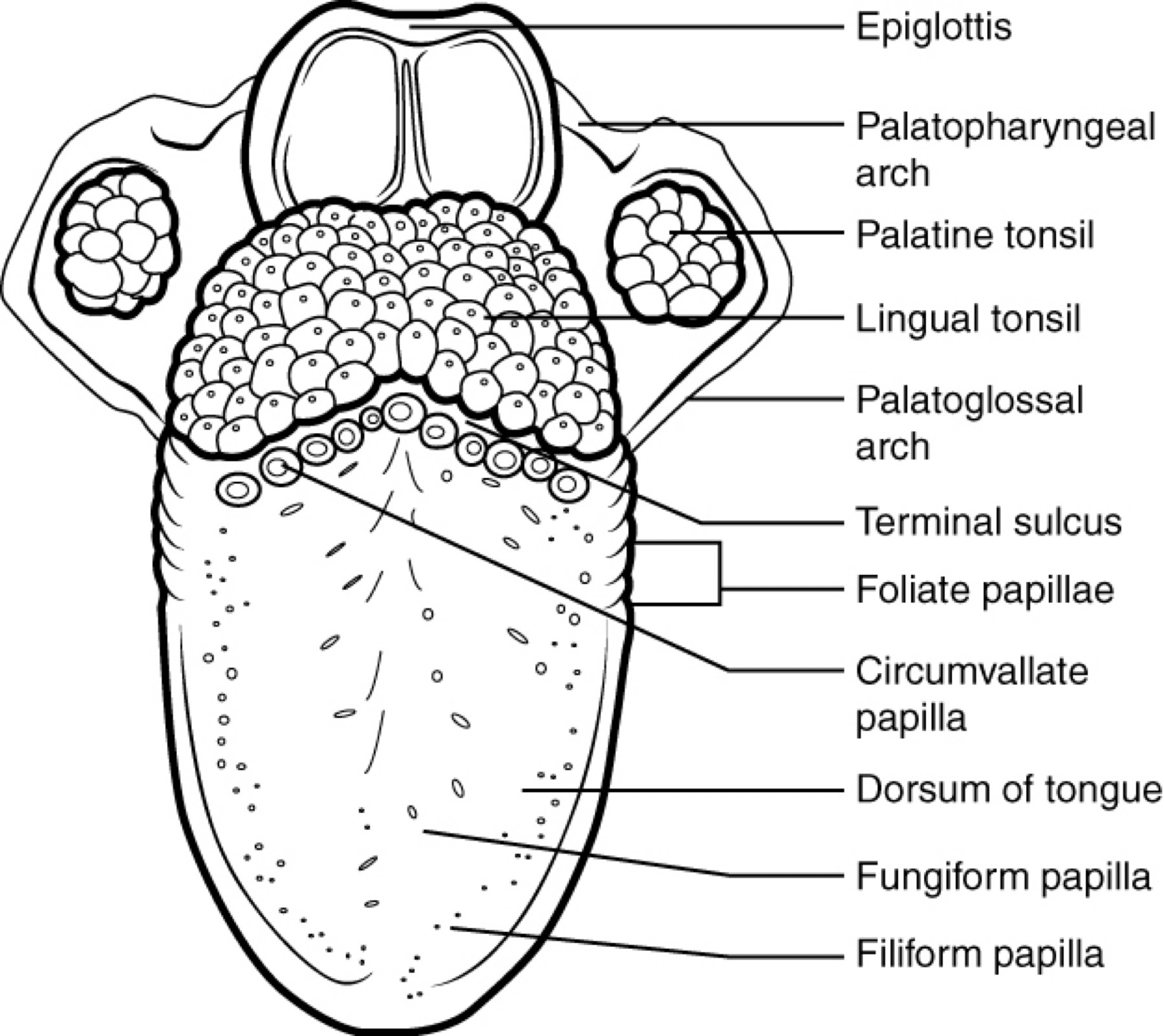
What divides the tongue into symmetrical halves?
Answer:
A medial septum
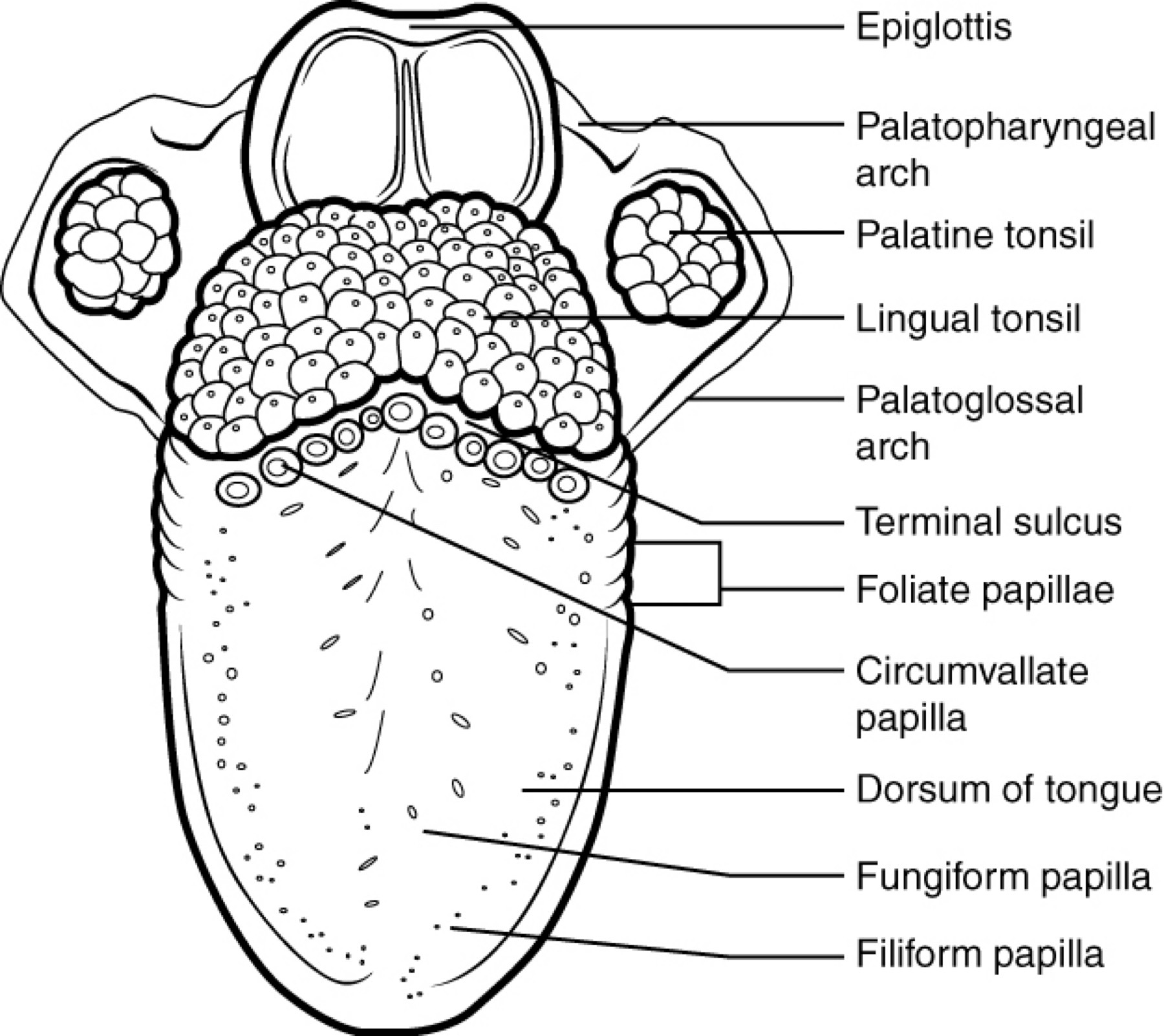
What are the intrinsic muscles of the tongue?
Answer:
Longitudinalis inferior
Longitudinalis superior
Transversus linguae
Verticalis linguae
👉 These control shape and size of the tongue
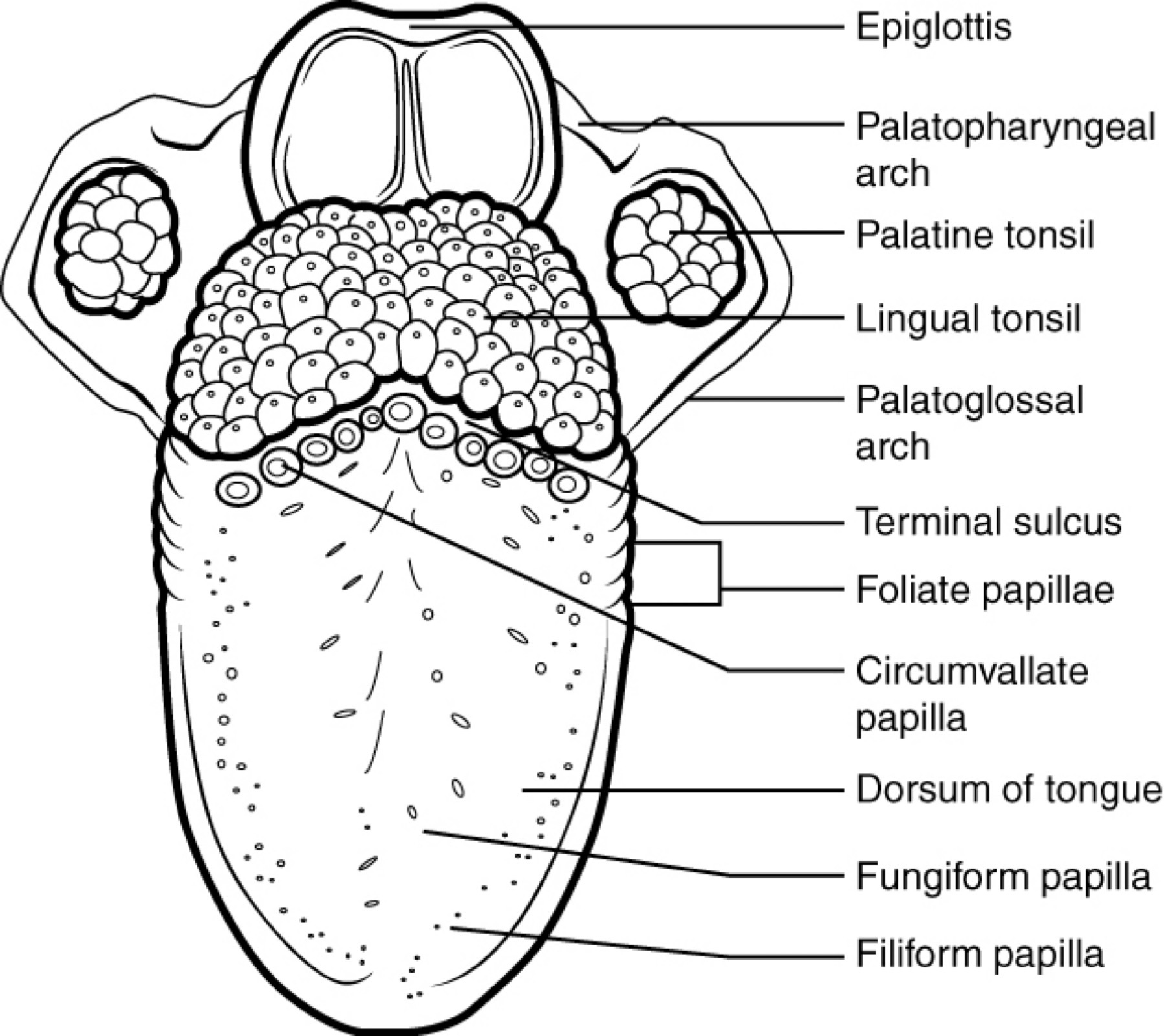
What are the extrinsic muscles of the tongue?
Answer:
Palatoglossus
Hyoglossus
Styloglossus
Genioglossus
👉 These control position of the tongue
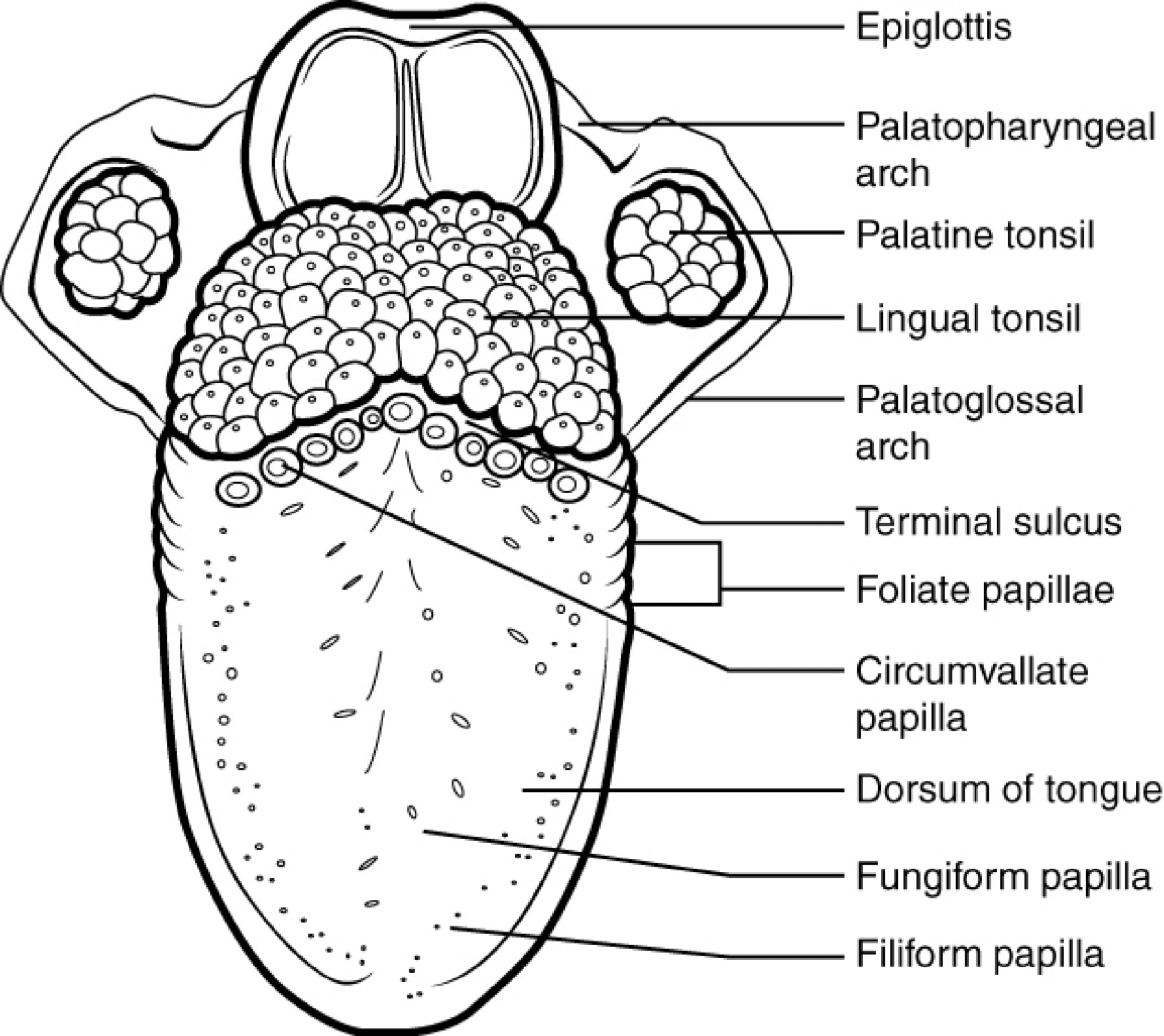
What are the digestive functions of the tongue muscles?
Answer:
Position food for chewing
Gather food into a bolus
Position food for swallowing
What does the mylohyoid muscle do?
Answer:
Raises the tongue
What does the hyoglossus muscle do?
Answer:
Pulls the tongue down and back
What does the styloglossus muscle do?
Answer:
Pulls the tongue up and back
What does the genioglossus muscle do?
Answer:
Pulls the tongue forward
What are papillae on the tongue?
Answer:
Projections of lamina propria covered in stratified squamous epithelium
What are fungiform papillae?
Answer:
Mushroom-shaped
Contain taste buds
Larger toward the back of the tongue
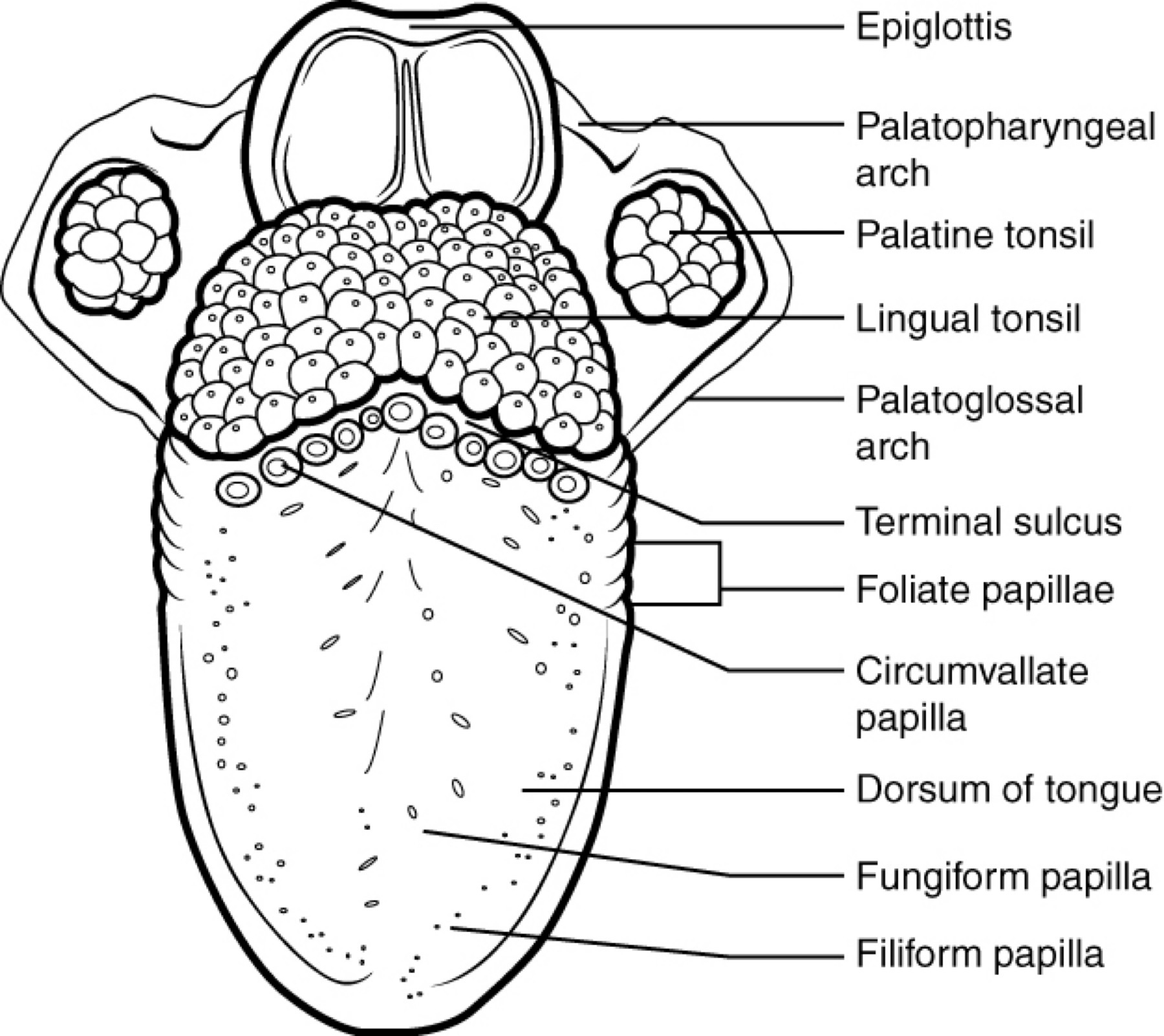
What are filiform papillae?
Answer:
Thin and long
Contain touch receptors
Help move food & create an abrasive surface
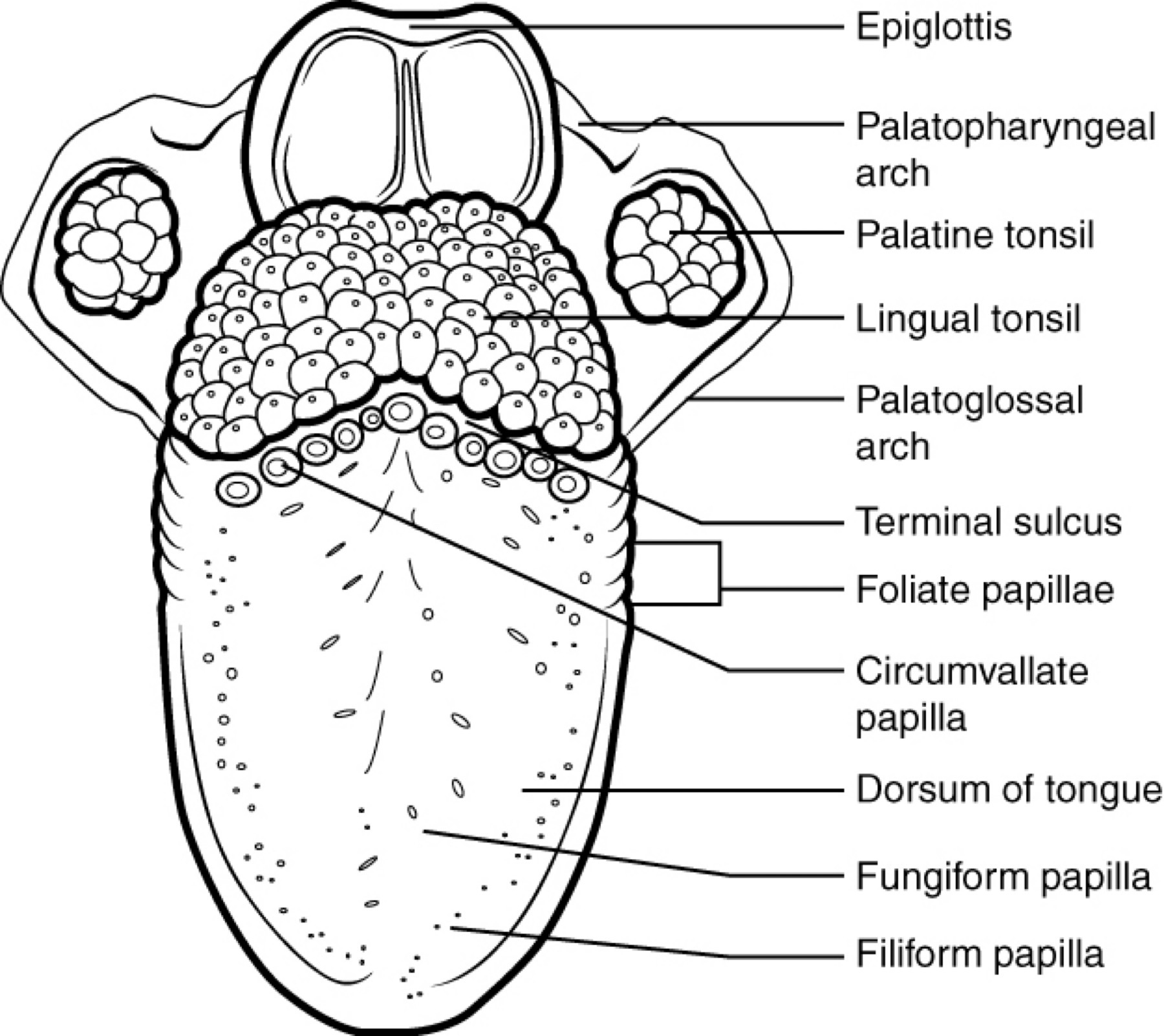
What enzyme is secreted by lingual glands?
Answer:
Lingual lipase – starts breaking down triglycerides in the stomach
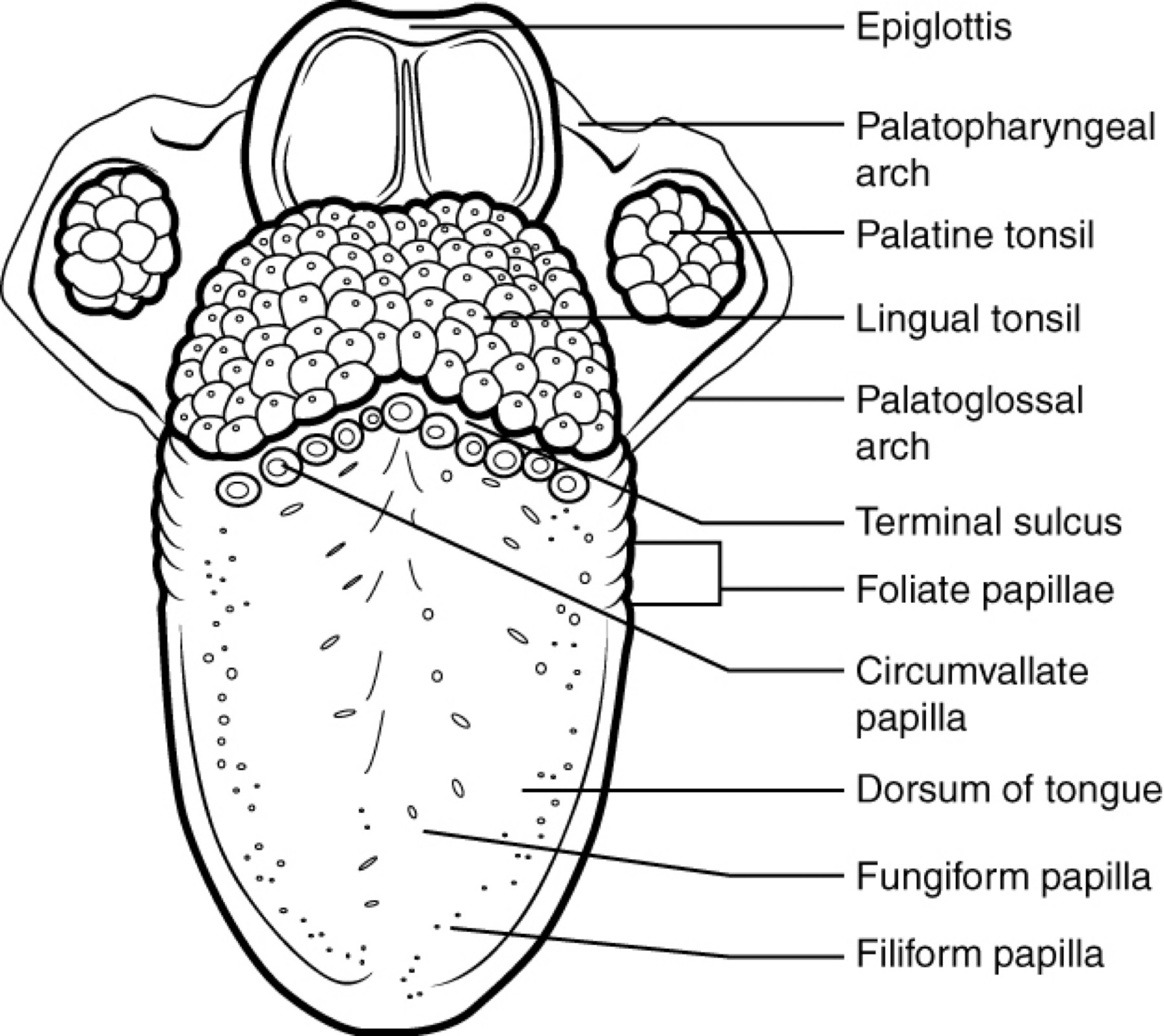
What is the lingual frenulum?
Answer:
A mucous membrane fold that tethers the tongue to the floor of the mouth
What is ankyloglossia?
Answer:
Also known as “tongue tie,” a condition where the lingual frenulum is too short, impairing speech or movement
What is the function of teeth in digestion?
Answer:
To tear, grind, and mechanically break down food
What is the term for one set of teeth?
Answer:
Dentition
How many deciduous (baby) teeth do humans have?
Answer:
20
At what age do deciduous teeth typically begin to appear?
Answer:
Around 6 months of age
How many permanent teeth replace baby teeth?
Answer:
32 permanent teeth
At what age are deciduous teeth replaced by permanent teeth?
Answer:
Between age 6 and 12
How many incisors are there and what is their function?
Answer:
8 incisors (4 top, 4 bottom)
Function: Biting into food
How many cuspids (canines) are there and what is their function?
Answer:
4 cuspids (2 top, 2 bottom)
Function: Tearing tough or fleshy foods
How many premolars (bicuspids) are there and what is their function?
Answer:
8 premolars (4 top, 4 bottom)
Function: Mashing food
How many molars are there and what is their function?
Answer:
12 molars (6 top, 6 bottom)
Function: Crushing food for swallowing
What are wisdom teeth?
Answer:
The third molars in each quadrant of the mouth; often erupt later in life (early adulthood)
What does it mean when a wisdom tooth is "impacted"?
Answer:
It fails to erupt and remains trapped in the jaw; often requires surgical removal
Where are teeth anchored?
Answer:
In the alveolar processes (sockets) of the maxilla and mandible

What is the gingiva?
Answer:
Also called the gums, the gingivae are soft tissues that line the alveolar processes and surround the necks of the teeth
What holds each tooth in place within its socket?
Answer:
The periodontal ligament, a strong connective tissue
Flashcard 16: What are the two main parts of a tooth?
Answer:
Crown – visible part above the gum line
Root – embedded in the maxilla or mandible
What is found inside the pulp cavity?
Answer:
Loose connective tissue, nerves, and blood vessels
What is the part of the pulp cavity that runs through the root called?
Answer:
Root canal
What is dentin?
Answer:
A bone-like tissue that surrounds the pulp cavity
What covers dentin in the root?
Answer:
Cementum, a type of modified bone
What covers dentin in the crown?
Answer:
Enamel, the hardest substance in the human body
What causes tooth decay (dental caries)?
Answer:
Bacteria feeding on sugars release acid, which erodes enamel and causes inflammation and degradation
Why is enamel important?
Answer:
It protects the dentin and pulp cavity from mechanical and chemical damage
What is mastication?
Answer:
Mastication is the initial phase of mechanical digestion where food is chewed in the oral cavity
What happens to food during mastication?
Answer:
Food is bitten off, ground by teeth, mixed with saliva, and turned into a soft pulp
What nerve supplies the muscles of mastication?
Answer:
The mandibular nerve, a branch of the trigeminal nerve (CN V)
What does the mandibular nerve also supply?
Answer:
Teeth and gums of the mandible
Mucous membrane of the anterior two-thirds of the tongue
Muscles of mastication
What muscle is the primary mover in chewing?
Answer:
The masseter, which elevates the mandible to close the jaw
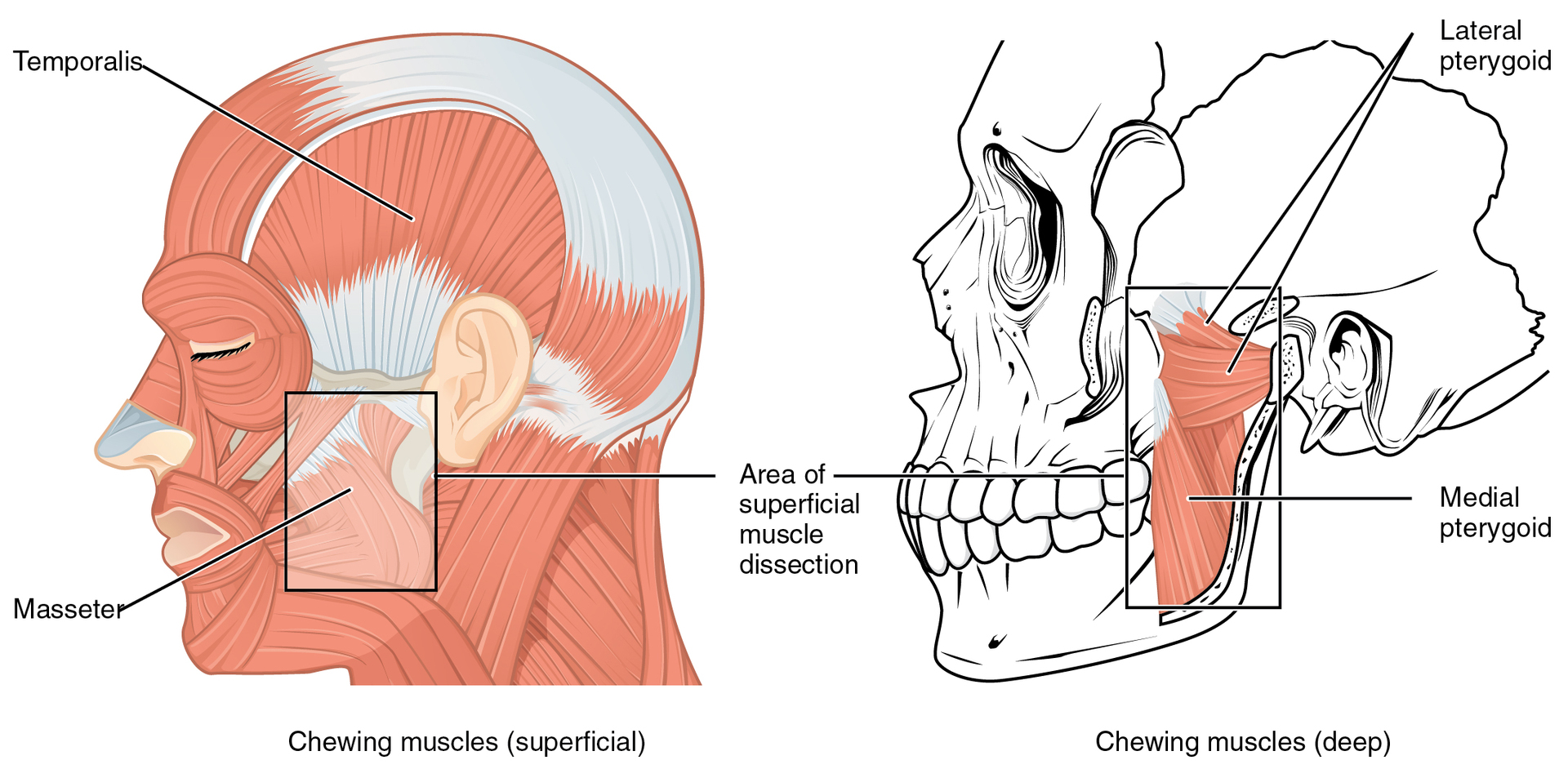
What muscle assists the masseter in retracting the mandible?
Answer:
The temporalis muscle
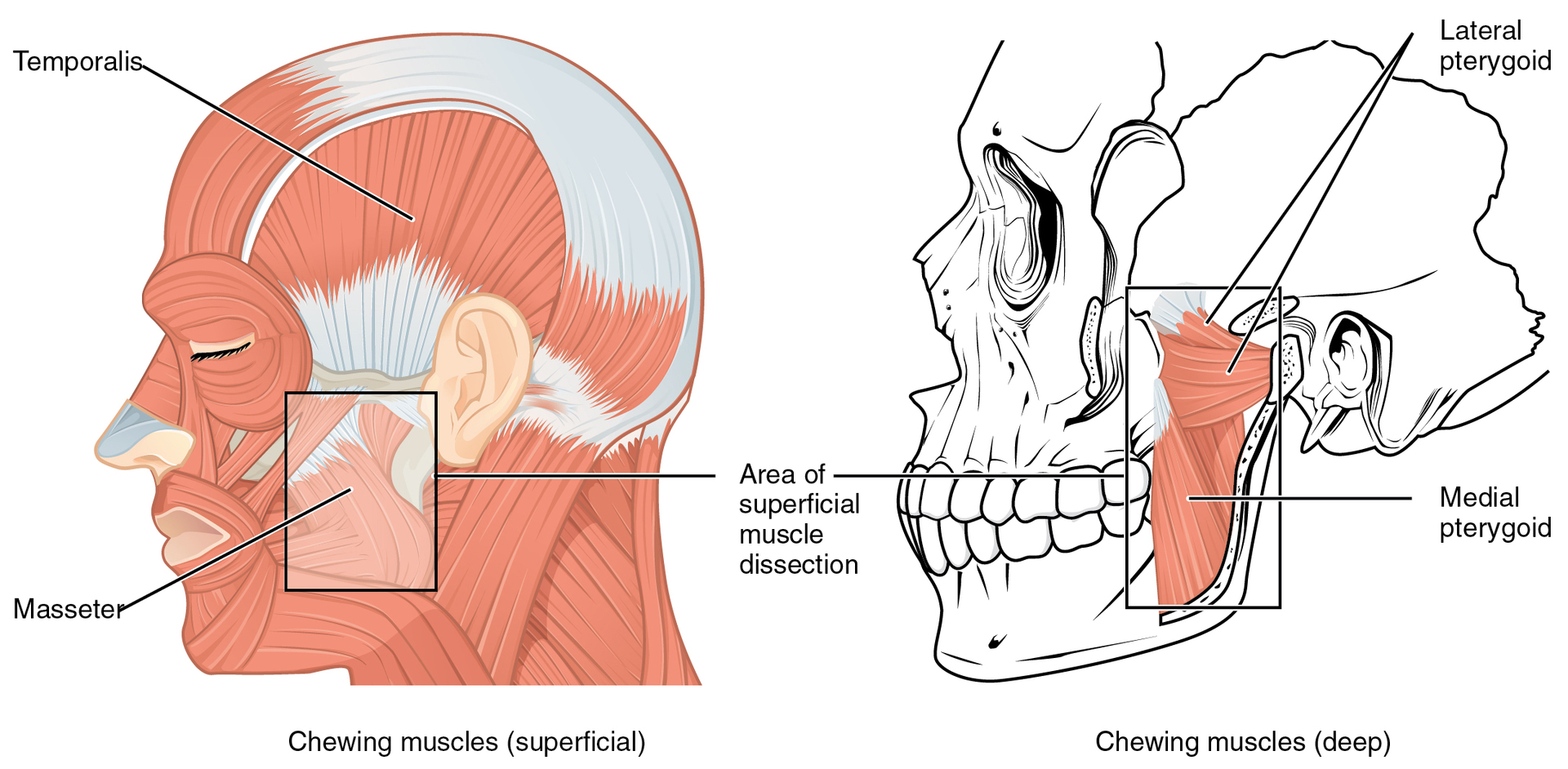

What is the role of the medial and lateral pterygoid muscles?
Answer:
They assist in chewing by helping move food within the mouth and aiding jaw movement
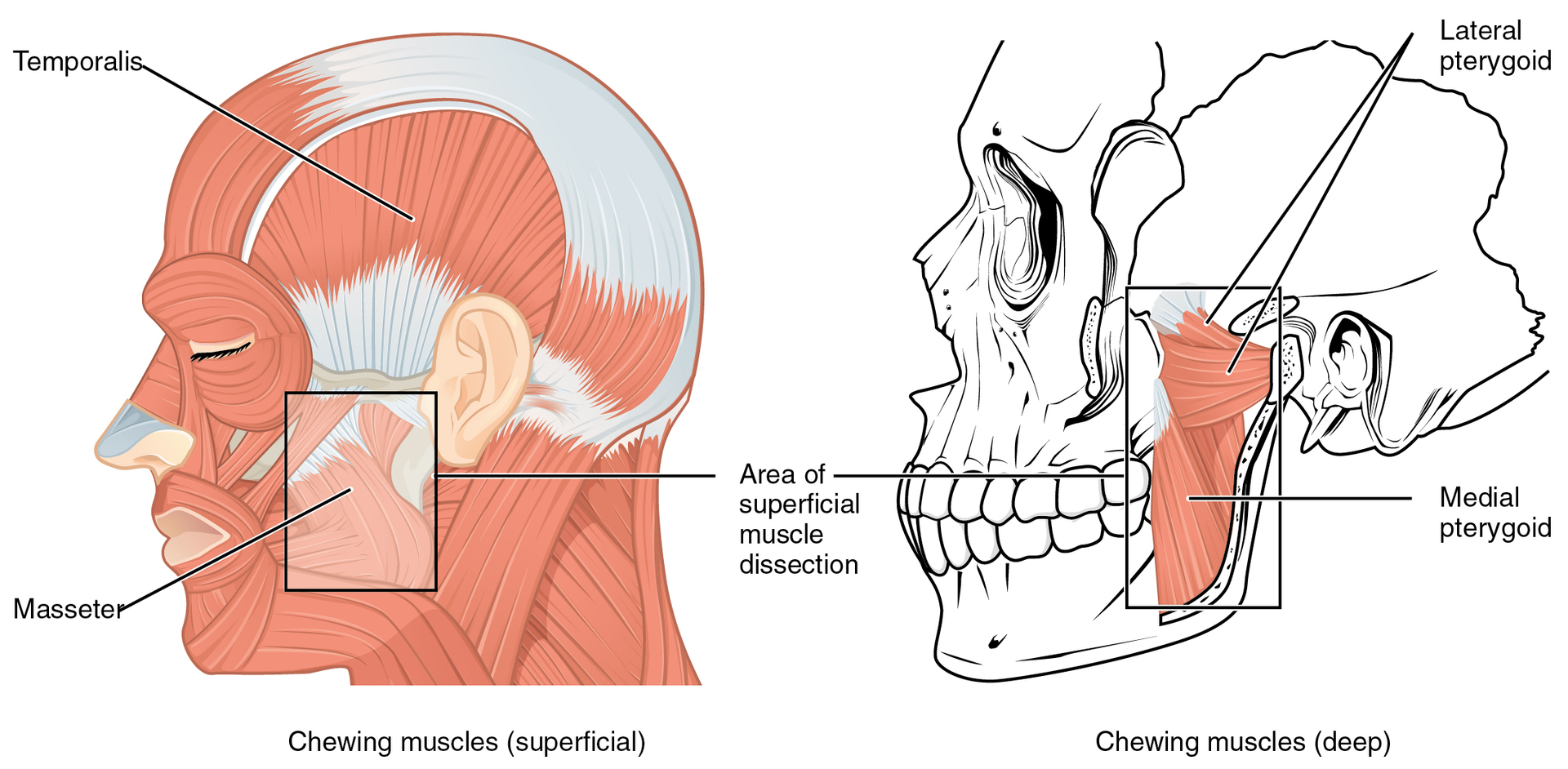
Which two muscles work together to elevate and retract the mandible during mastication?
Choose 2 answers.
Masseter
Temporalis
Medial pterygoid
Lateral pterygoid
Masseter
Temporalis
What two systems is the pharynx involved in?
A: Digestion and respiration.
Q: What does the pharynx receive?
A: Food and air from the mouth, and air from the nasal cavities.
Q: What happens in the pharynx when food enters it?
A: Involuntary muscle contractions close off the air passageways.
Q: What is the pharynx made of?
A: Skeletal muscle lined with a mucous membrane.
Q: Where does the pharynx run from and to?
A: From the posterior oral and nasal cavities to the opening of the esophagus and larynx.
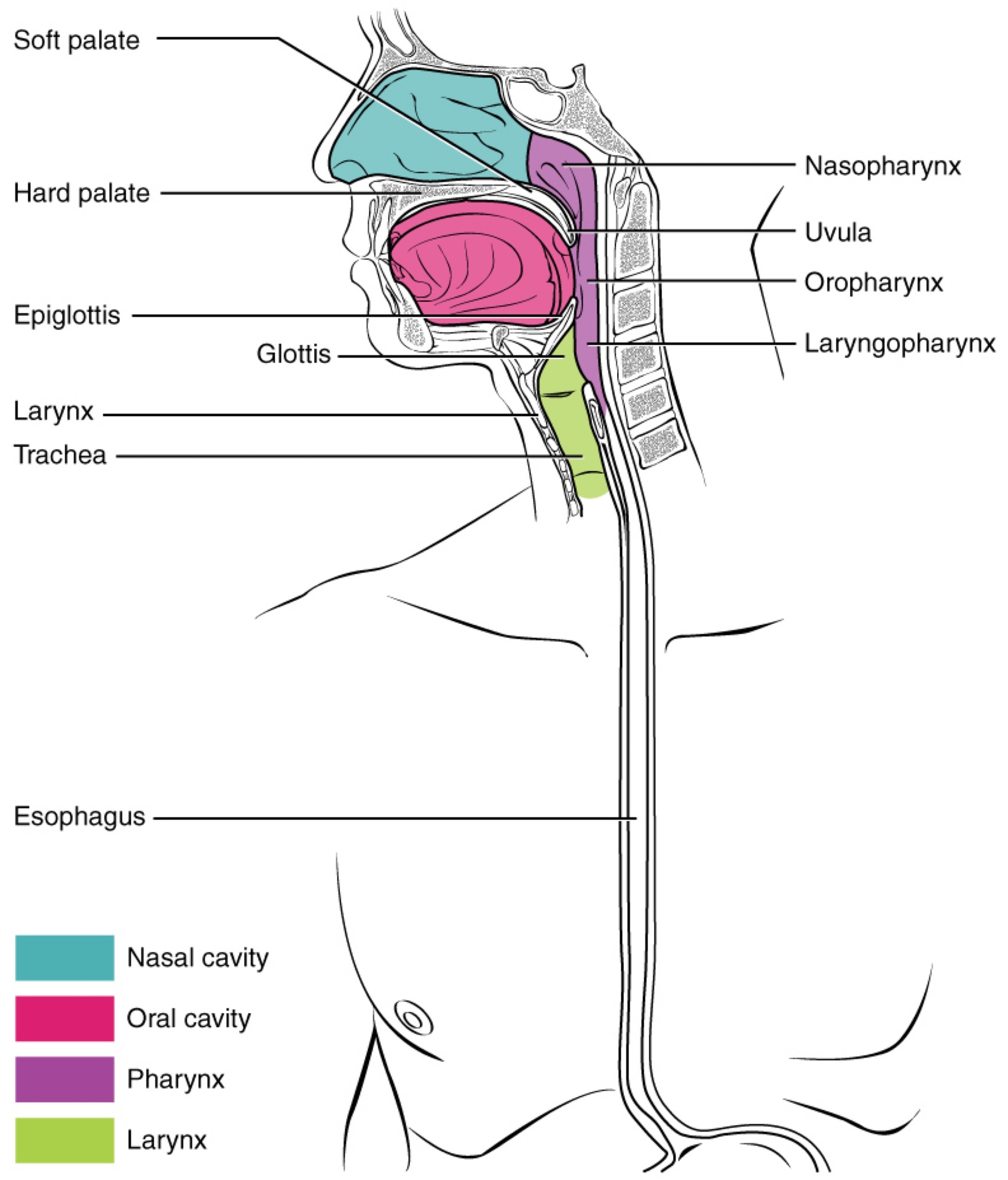
Q: What are the three subdivisions of the pharynx?
A: Nasopharynx, oropharynx, and laryngopharynx.
Q: Which subdivision of the pharynx is involved only in breathing and speech?
A: The nasopharynx.
Q: Which subdivisions of the pharynx are used for both breathing and digestion?
A: The oropharynx and laryngopharynx.
Q: Where does the oropharynx begin and continue to?
A: It begins inferior to the nasopharynx and continues below to the laryngopharynx.
Q: What connects to the inferior border and anterior portion of the laryngopharynx?
A: The esophagus (inferiorly) and the larynx (anteriorly).
Q: What type of epithelium lines the oropharynx?
A: Stratified squamous epithelium.
Q: What kind of glands are present in the mucosa of the oropharynx?
A: Mucus-producing glands.
Q: What happens to the pharynx muscles during swallowing?
A: Elevator muscles contract to receive the bolus, then relax as constrictor muscles contract to push the bolus into the esophagus.